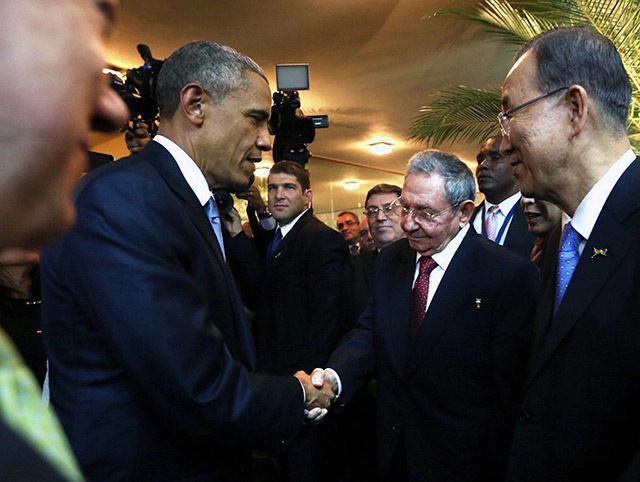SUMMARY
This is AI generated summarization, which may have errors. For context, always refer to the full article.

PANAMA CITY, Panama – While the meeting between presidents Barack Obama and Raul Castro will mark a milestone in the US-Cuban diplomatic thaw, they remain a long way from untangling decades of hostile ties.
The two leaders will hold talks on the sidelines of the Summit of the Americas in Panama City on Saturday, April 11, and they are expected to take stock of negotiations that started in January.
The two sides are striving to reopen embassies that closed when relations broke in 1961, but there is a slew of thorny issues to resolve:
What has been achieved
In January, a month after Obama and Castro announced their intention to restore ties, the US leader eased some trade and travel restrictions.
Poking holes at the US embargo, Obama made it easier for 12 categories of Americans to visit the communist islands, no longer requiring them to apply for a license before traveling.
But regular tourism remains off limits. Trips are limited to specific visits including education, sports, culture or journalism.
Those allowed to visit Cuba can bring back home $100 worth of cigars or rum, and pay for purchases on the islands with credit cards.
US companies are now allowed to invest in Cuba’s tiny but growing private sector, which emerged under modest economic reforms launched by Castro.
Last month, the two countries re-established a direct telephone link.
In late March, the US Treasury Department removed sanctions on some 60 individuals, shipping companies and trading firms that had been blacklisted for links to Cuba.
Awaiting embassies
So far, the negotiations have mostly focused on reopening embassies.
Top US and Cuban diplomats launched the talks in January in Havana and met again in Washington in February. Technical discussions on human rights were held in the US capital last month.
The United States wants Cuba to remove travel restrictions for its diplomats on the island and allow unfettered access to ordinary Cubans.
The main sticking point for Cuba is the communist government’s inclusion on a list of state sponsors of terrorism, which includes Iran, Syria and Sudan.
The blacklist restricts Cuba’s access to global bank credits.
The White House said the US State Department has completed a review of the list but that Obama has yet to decide what to do. (READ: Obama advised to take Cuba off terror list)
If Obama decides to remove Cuba from the list, Congress will have 45 days to decide whether to override the move.
Toughest item: Embargo
The biggest obstacle to the broader goal of normalizing relations is the US embargo, which was imposed during the Cold War in 1962.
Obama has urged Congress to lift the embargo, but some lawmakers are opposed. The US 2016 presidential election could also heat up the debate.
Castro has asked for compensation for the “human and economic damage” caused by the embargo, which the government estimates has cost the island $116 billion. (READ: Cuba’s Castro to US: End embargo to mend ties)
The former guerrilla fighter has also demanded that the United States return the “illegally occupied” territory of Guantanamo Bay on the island’s eastern edge, where a US naval base and terror-suspect prison camp is located.
The United States has its own financial gripe over the expropriations conducted by the Fidel Castro regime after the 1959 revolution.
The US estimates the nationalization cost Americans $7 billion.
Washington wants Cuba to take back Cubans living in the United States who have criminal records. So far, Havana has only accepted six of some 25,000 people. – Rappler.com
Add a comment
How does this make you feel?
There are no comments yet. Add your comment to start the conversation.